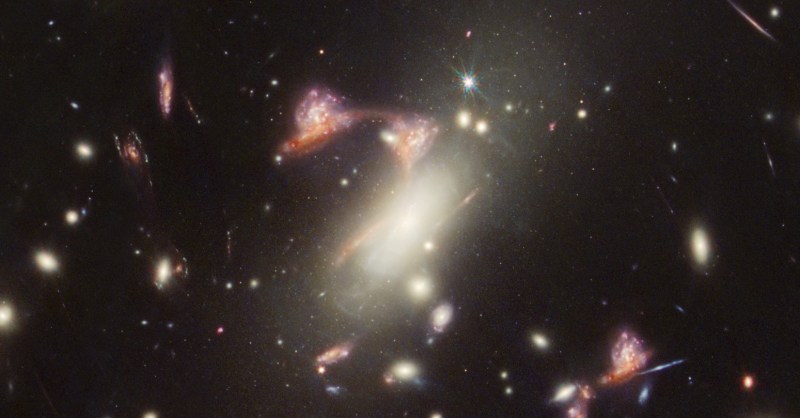The Webb Space Telescope Spots Another ‘Question Mark’ Galaxy
The internet had a lot of fun last year when eagle-eyed viewers spotted a galaxy that looked like a question mark in an image from the James Webb Space Telescope. Now, Webb has stumbled across another questioning galaxy, and the reasons for its unusual shape reveal an important fact about how the telescope looks at some of the most distant galaxies ever observed.
The new question mark-shaped galaxy is part of an image of galaxy cluster MACS-J0417.5-1154, which is so massive that it distorts space-time. Extremely massive objects — in this case, a cluster of many galaxies — exert so much gravitational force that they bend space, so the light traveling past these objects is stretched. It’s similar using a magnifying glass. In some cases, this effect, called gravitational lensing, can even make the same galaxy appear multiple times in different places within one image.
This particular case is the result of the Earth, the galaxy cluster, and the target galaxy lining up just so, and it’s called a hyperbolic umbilic gravitational lens. There is actually one pair of galaxies here, but the lensing makes it appear five times and creates the question mark shape.
“We know of only three or four occurrences of similar gravitational lens configurations in the observable universe, which makes this find exciting, as it demonstrates the power of Webb and suggests maybe now we will find more of these,” said astronomer Guillaume Desprez of Saint Mary’s University in Halifax, Nova Scotia, in a statement.
The image was taken with Webb’s NIRCam instrument, but the researchers also used Webb’s NIRISS instrument to pick out where star formation was occurring, even in a galaxy located billions of light-years away. The rate of star formation can be ramped up when two galaxies are in the process of merging or colliding.
“Knowing when, where, and how star formation occurs within galaxies is crucial to understanding how galaxies have evolved over the history of the universe,” said astronomer Vicente Estrada-Carpenter of Saint Mary’s University. “Both galaxies in the Question Mark Pair show active star formation in several compact regions, likely a result of gas from the two galaxies colliding. However, neither galaxy’s shape appears too disrupted, so we are probably seeing the beginning of their interaction with each other.”
As well as being a fun oddity, the galaxies seen here are useful models of what our own galaxy was like when it was younger.
“These galaxies, seen billions of years ago when star formation was at its peak, are similar to the mass that the Milky Way galaxy would have been at that time. Webb is allowing us to study what the teenage years of our own galaxy would have been like,” said Marcin Sawicki of Saint Mary’s University.
The research is published in the Monthly Notices of the Royal Astronomical Society.
Georgina Torbet — Space Writer
Georgina is the Digital Trends space writer, covering human space exploration, planetary science, and cosmology. She…
Source: www.digitaltrends.com


